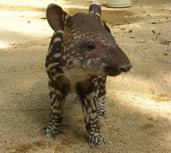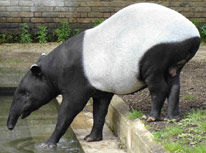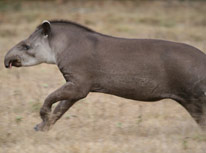Tapiridae - What a quivering nose you have....
Origins
The family Tapiridae(Tapyra as called by indigenous Brazilians) is said to have arisen in what is now North America during the early Eocene and spreading to Asia during the Miocene and to South America during the Pleistocene.
What are they Like
Tapirs possess several conservative physical features, resembling the earliest perissodactyls in several ways, notably retaining the ancestral fourth digit on the front feet. - they have not developed the cursorial adaptations of the equids, nor the high-crowned teeth for grazing on grass.
The upper lip and nose of tapirs are extended into a short and grasping (prehensile) trunk, which is one of the most recognizable features of this group. To accommodate this nose (proboscis), the nasal bones of the skull are short and project forward.
Geographic Distribution
Tapirs have an unusual geographic distribution - they are the only New World perissodactyls (three species inhabit Central and South America), but one species is native to Asia. The fossil record indicates this group evolved in what is now North America, spread to Asia and then to South America. Subsequently, tapirs became extinct across most of North America, probably due to climate change - southern Mexico is currently the most northern extent of the range of Baird's tapir (Tapirus bairdii).
Reproduction
Infant tapirs are born after 13 months of pregnancy and possess a striking pattern of white stripes and spots over their bodies, providing camouflage for their first 5-8 months. They have too many predators and the parents need to keep a sharp nose in such times.
Feeding Habits
Tapirs are forest animals and feed on softer leaves and plants. They are not above eating fruit either. When feeding, their long grasping snout works just like a hand would for you and me.
Species within this family
Tapirus bairdii (Baird's Tapir)
Tapirus indicus(Asian Tapir)
Tapirus pinchaque(Mountain Tapir)
Tapirus terrestris(Brazilian Tapir)
Videos


